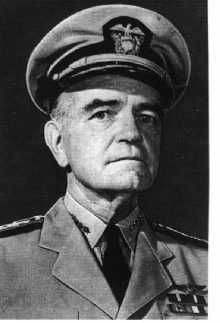

| Admiral
William Frederick Halsey
Born: 30 October 1882, Elizabeth, New Jersey Died: 16 August 1959, Fisher's Island, Connecticut Nickname: "Bill" for his friends, but "Bull" by the press |
 |
Falling ill shortly thereafter, with a skin infection, Halsey missed the Battle of Midway (having missed Coral Sea because of the Doolittle Raid), but contributed to it's success by appointing Raymond Ames Spruance as his successor in command of the Enterprise/Hornet group.
After having recovered, Halsey replaced Vice-Admiral Ghormley as Commander, South Pacific, in which post he performed most distinguishedly. Under his command the U.S. naval forces in the area won the Naval Battle of Guadalcanal, and lost the Battle of Santa Cruz. Subsequently, after the capture of Guadalcanal, his forces stepped up the Solomons. On his order, Admiral Frederick C. Sherman conducted the brilliant raid on Rabaul in November 1943.
With the
conclusion of the Solomons campaign, Admiral Halsey, a full admiral since
late 1942, was ordered to command the fast carriers in the Central Pacific.
Upon taking command as COMTHIRDFLT, Halsey began to attack Japanese positions
in the Philippines in September 1944. Discovering that the defenses of
Leyte, the next target on the list, where weaker than expected, Halsey
suggested that the attack scheduled for late (20th) December should be
conducted in October, a full two months earlier.
Having
been given approval to his plan, Halsey, though referred to as COMTHIRDFLT,
continued to serve as virtual fast carrier commander, since his amphibious
groups were transfered to Admiral Kinkaid's 7th Fleet.
In this role, Halsey controlled
the U.S. actions at the Battle of the Leyte Gulf. His dash north, to get
to Admiral Ozawa's carrier fleet, left the critical passage of San Bernadino
uncovered. On the whole, the battle did not go as Halsey had planned -
which he hadn't. Though his fleet sank the four carriers of Ozawa, it missed
the two converted battleships, and a major part of the escort units. Meanwhile,
Admiral Kurita's Center Force had slipped by, and attacked Kinkaid's covering
escort carrier force "Taffy 3".
Though
Halsey turned his forces, Kurita went back to his base unattacked. Halsey
has sunk four carriers, a superbattleship, and several smaller ships. He
had lost the Light Carrier Princeton, and jeopardized the invasion beaches.
Though much blame must also rest with Kinkaid and his subordinates, Halsey
was responsible for destroying the Japanese fleet, which included carriers
but was not restricted to them. Halsey failed to see which force was more
dangerous, and paid the price.
Following
the closure of the Philippines campaign, Halsey was replaced by Admiral
Spruance as COMTHIRDFLT, which became the Fifth Fleet accordingly, and
went back to Pearl Harbor planning the next operations against Japan. After
the Okinawa operation, he replaced Spruance again, and hit Japan with the
Fast Carriers until the end of the war. As Fleet Admiral, Halsey spent
the rest of his career in Washington, D.C., and was retired in 1947.
Halsey was and is a highly controversial figure in the U.S. Navy. He never really distinguished himself in his campaigns, and yet, due to his incredible popularity and his ability to encourage his men, won all of them. Halsey was definitely not brilliant - under his command responsibility fell the losses of Hornet, Chicago, Princeton and Gambier Bay, all of which could have been probably avoided through careful planning. On the other hand, his fighting spirit resulted in the succesful raids on Rabaul, and the early invasion of Leyte, shortening the war by months, as well as the appointment of Spruance as COMTF16 at Midway. I'll go with what J.J.Clark said of him: by 1944, the war had become too complicated for Halsey. But before that, Halsey was the only one man to turn the problematic situation at Guadalcanal in favor of the Allies.